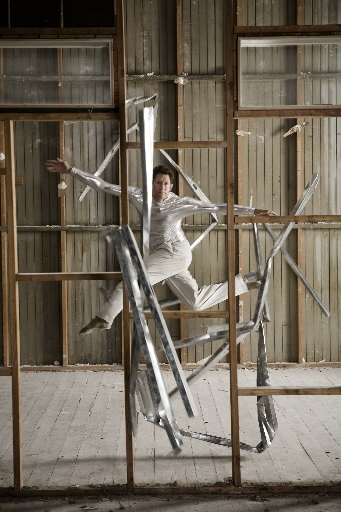 So, Art Scatter had an interesting weekend, with the odd charm’s of BodyVox and Holcombe Waller taking center stage. We’ve posted about this on Portland Arts Watch, and we’ll just take a moment to emphasize a point or two from that post.
So, Art Scatter had an interesting weekend, with the odd charm’s of BodyVox and Holcombe Waller taking center stage. We’ve posted about this on Portland Arts Watch, and we’ll just take a moment to emphasize a point or two from that post.
BodyVox’s “The Foot Opera Files” was very close to something special thanks to the strangeness of trained voices from the Portland Opera’s studio artists program taking on the songs of Tom Waits; the downscale theatricality of the costumes from the wrong side of the tracks; live music from an excellent little combo; the raw space that will become BodyVox’s new home. What it needed to go all the way was the darkness of Waits, the sorrow, as a contrast to the vaudeville shtick, which sometimes was quite good and sometimes wasn’t as startling as it needed to be. Without the sorrow, it can all seem like an “adventure” in the tenderloin or like playacting. Which it is, of course, but that’s probably not what you’re hoping to convey. Anyway, it runs again Wednesday-Sunday, and I’d love to compare notes.
Holcombe Waller is pretty amazing. “Into the Dark Unknown: The Hope Chest” was basically a concert featuring Waller with his back-up band, the Healers, but it had video and multiple performing locations on the stage, including a table on which Waller sat or on which were stacked boxes on which Waller sat. All of the details seemed carefully choreographed and rehearsed, which was nice, an antidote to our reigning informality, which sometimes slips into territory best called “sloppy.” Waller has an entirely different aesthetic going on, and good for him.
I also like the clarity of Waller’s voice, which also shows great attention to detail, and his songs are carefully made too, simple and dramatic, with stylish effects, both for voice and instruments. The concert wasn’t for the depressed: I’d say the overall emotional tone was “plaintive.” And as I said on Arts Watch, I liked the pieces best that had some fight in them.
Waller is a singular performer in Portland, though he is working in San Francisco and New York, too, these days, he told us. I hope we stay a point on his triangle because it will be interesting to watch him balance some contradictory impulses in his art.
In my column in The Oregonian today, I talked about art and politics, inspired by last week’s “24/7” show at Wieden+Kennedy. And what I was trying to say, really, was something simple: The wisdom inherent in a great work of art is a model for us to emulate in the rest of our lives, including our citizenship in a democracy, an insight of John Dewey’s really. And that’s an interesting way to think about art — how wise is it? What forces does it balance? What conflicts does it resolve? How useful are its descriptions of reality — either the external or the internal? What paths does it blaze for us in our thinking about art itself or in thinking about life?